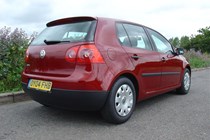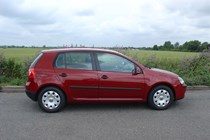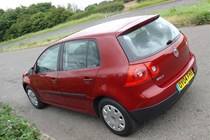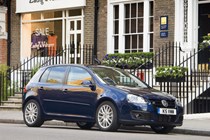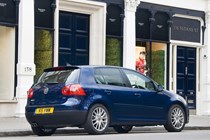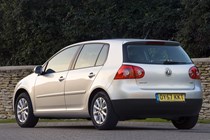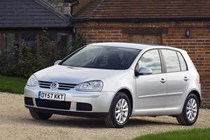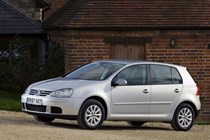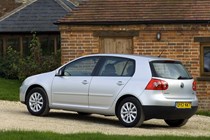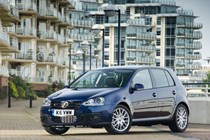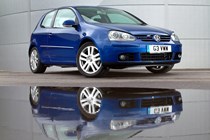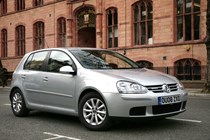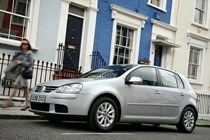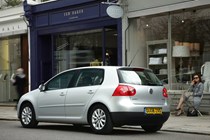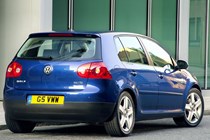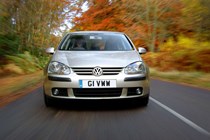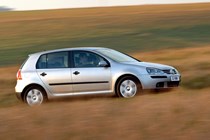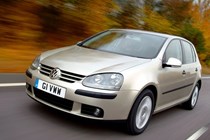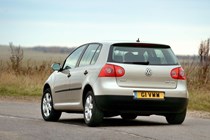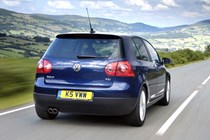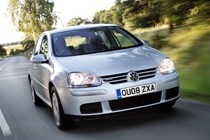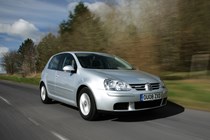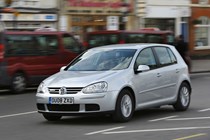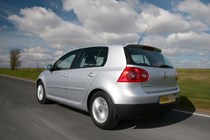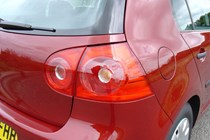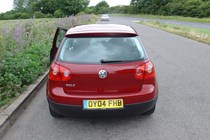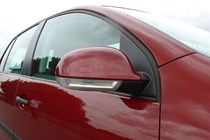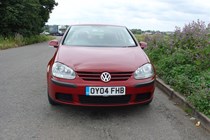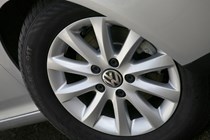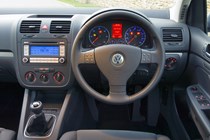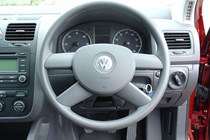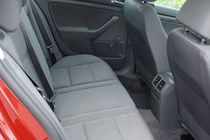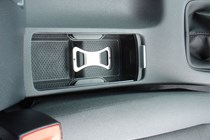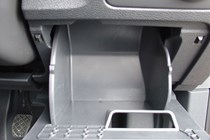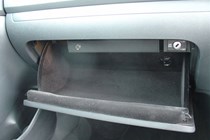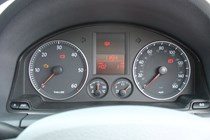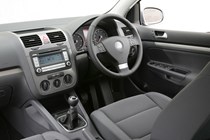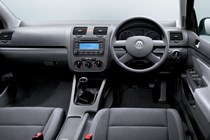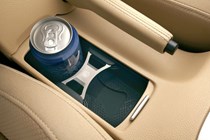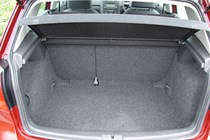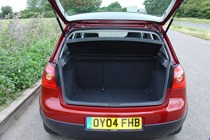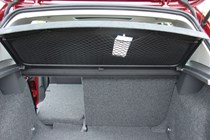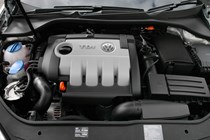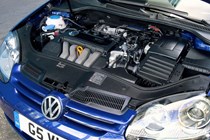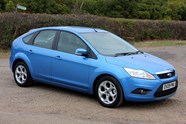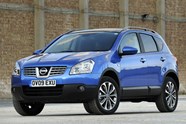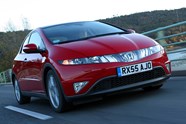
Volkswagen Golf Hatchback (2004-2008) review
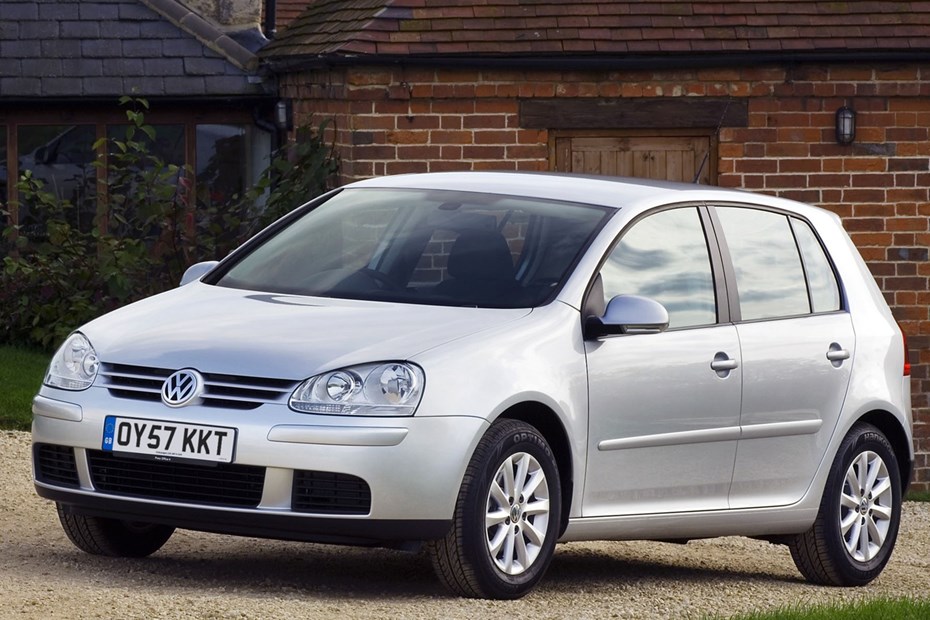
At a glance
| Price new | £11,845 - £21,640 |
|---|---|
| Used prices | £348 - £3,714 |
| Road tax cost | £35 - £430 |
| Insurance group | 6 - 32 |
Get an insurance quote with

|
|
| Fuel economy | Not tested to latest standards |
| Range | 387 - 750 miles |
| Number of doors | 3 - 5 |
| View full specs for a specific version | |
Available fuel types
Petrol
Diesel
Pros & cons
- Great engines and good to drive
- Well-finished and spacious interior
- Plenty of specialist support out there
- A class act, but it's not infallible
- Watch for DMF issues on cars with miles
- Most rivals are comfortably cheaper
Volkswagen Golf Hatchback (04-08) rivals
Overview
The Volkswagen Golf Mk5 launched in 2004, and built on the strong foundations of the Golf Mk4’s platform. A new family look modernised the elegant profile of its predecessor with more visual drama and bold identity, while the interior gained space, sophistication and a touch of the Audi A3‘s premium feel. The engineering improved as well, starting with well-rounded handling that offered a more dynamic experience.
Expanding the range of engines available, a greater variety of TDI turbodiesels and small TSI turbo petrols improved economy. VW’s sophisticated new dual-clutch automatic gearbox, called DSG, made its debut in the regular Golf range and the Golf GTI was reinvigorated as a proper hot hatch again.
Completing the range, a thrilling encore of the 3.2-litre V6 R32 followed (the 170hp GTD has more torque, though) –yet the Golf Mk5 would be short-lived. In 2009 the Golf Mk6 took over, albeit as more of a heavy facelift than a significantly new model.
Volkswagen Golf Mk5 buying guide
Today, the Golf Mk5 represents good value for money if you can find a good one. The used car market has done its work and brought prices down to a very affordable level – but all the inherent qualities of the car are still intact, so it remains a cut above many of the alternatives.
Just make sure you don’t get caught out by some of the pitfalls of buying a Golf Mk5: it’s a quality car, but it still goes wrong. Check these areas carefully to get yourself a touch of class that won’t lead to headaches or unwelcome big bills…
VW Golf Mk5 known faults and common problems
1. Rust on the bodywork
The earliest Mk5 Golfs are now approaching 20 years old, which means there’s a real risk of rust. The Golf is particularly susceptible around the front and rear wings, not helped by the plastic wheelarch liners rubbing away the paint and leaving exposed metal. Before viewing the car, check its MOT history online as any advisories or fails will give you shortcuts to places to shine a torch.
Pay close attention to the sills, particularly where they meet the front wings. Rust patches can emerge around the Volkswagen logo on the tailgate, which doubles as the boot release if you press the badge itself.
Lift the boot carpet as well. Water can leak past door seals and from clogged sunroof drains and fill the boot floor, plus it’s a good point to check for accident damage.
2. Which VW Golf MkV engine is best?
Lower-end petrol engines are weedy: the 1.4-litre only has 75hp, while the 1.6-litre FSI isn’t exactly a ball of fire either (and it only works best if run on super unleaded petrol). The 1.4 TSI from 2006 is far better: it had either 140hp or 170hp. But most Mk5 Golfs were diesel, fitted either with either a 1.9 TDI unit, or the newer and appreciably less clattery 2.0 TDI which had either 140hp or 170hp. A well-serviced 2.0 TDI is our pick of the diesels (avoid the 2.0 SDI as it doesn’t have a turbo and is very slow, taking nearly 17 seconds to reach 62mph…).
Excessive engine vibration is another tell-tale – because the DMF, when working correctly, is designed to reduce engine vibration. Total DMF failure will lead to the engine literally shaking.
3. VW Golf Mk5 timing chain or cambelt?
With such a diverse range of engines, knowing what to expect under the bonnet of a Golf isn’t straightforward. Most have belts, but 1.4-litre TSI and FSI Golfs have a timing chain. Listen for rattles at startup and when idling. If you have access to a diagnostic computer see if you can check the timing chain stretch.
On other models, check the service history. The Golf’s timing belt needs changing every four years or 70,000 miles. Don’t just look for a stamp – if there’s no receipt, look for evidence the belt has been changed. It’s a slightly tricky job as the exhaust manifold has to come off – and experts recommend changing the water pump and cam belt tensioners at the same time.
Some models have a short timing chain as well as a belt, to drive the second camshaft. Scraping, rattling near the top of the engine suggests issues there, but they are rare.
4. Stance – broken or modified?
Rear springs can break: a giveaway is the car having an odd, uneven stance on the road. Some versions also suffer from weak rear dampers, which you’ll be able to detect from excessive tyre wear on the inside of the rear wheels. A droning noise from the rear, sounding a bit like a worn wheel bearing, is another sign the dampers need replacing.
Some cars will be modified with suspension adjusted to lower the car and make the wheels tuck in at the top. If this is to your taste, make sure the tyre wear is even and everything has been done to a high standard – we would avoid a modified car like this as a daily driver or first car, even if it’s cheap or looks cool, because the handling is less safe and some modifications can make the car unroadworthy.
5. Dual mass flywheel failure
Many Mk5 Golfs, both manual and DSG, use a Dual Mass Flywheel, or DMF. This can fail, and it’s an expensive fix (particularly as it’s best to replace the clutch at the same time). Symptoms include a scratching or grinding noise at cold idle and a rattling noise from the gearbox – some describe it as sounding like pebbles in the gearbox. It may reduce if you press the clutch pedal, but return when you release it (the pedal may feel jerky as you do this, too).
6. Interior wear and damage
The beautiful blue lighting first seen in the Golf Mk4 carries over to the Golf Mk5 – it looks fantastic at night. Apart from a susceptibility for early cars to rattle, the interior is robust and good quality, although at this age, there may be signs of wear.
One of the most common signs of age is the soft rubber coating on the door handles and other parts of the dashboard wearing away, leaving shiny plastic showing through beneath (the door handles can feel sticky to the touch, too). Cars with sports seats may also show signs of bolster wear on the driver’s side: make sure it isn’t threadbare.
7. Heating and ventilation
Check the air conditioning works, as repairing it is pricey. If you’re lucky, it will just be a high pressure switch failure; if you’re not, you’ll have to fork out hundreds for a new air con compressor or condenser. This is a common weak point on older, leggier Mk5 Golfs, so it’s also worth listening out for any unusual noises even if the air con is blowing cold.
It’s a good idea to listen carefully for odd noises while you turn the A/C button off and on again. Some gurgles/hisses behind the dash are normal, but a continued hiss is unusual. The compressor will make a rumbling noise if it is low on gas – left like that, it will eventually wear out.
8. Gearboxes – manual and DSG
Manual gearboxes are generally robust. A heavy clutch pedal is a sign the clutch is on its way out, but the gearboxes themselves are pretty reliable.
Problems with the DSG can be more commonplace. It needs servicing, and has its own oil and filter. If it’s slow to shift, hunts for gears or is jerky during changes, it’s been neglected. Also watch out for lurching when pulling away and rumbling noises when stationary.
9. Diesel engine – TDI turbo
Turbochargers on TDI diesels can wear out, particularly at higher mileages. Watch out for smoky exhausts and excessive whistling under acceleration – and the engines shouldn’t feel lethargic when accelerating either, particularly the 2.0-litre TDI. Replacing a turbo is an expensive job, and if you’ve picked up a bargain Golf Mk5, the whole job can match the price of the car…
10. Doors and windows
Door seals can fail to do their job, with a giveaway being damp footwells, particularly in the rear. If there’s excessive whistling from the door frames, this is also a sign the door seals are past their best. It’s also worth looking around the tail lamps for signs of water ingress; the units can often let in water and it’s a really tricky job to find and repair – often, replacing the tail lamp is the only solution, particularly as it’s not too expensive.
Window runners can fail on the Golf Mk5 due the design of the clips used. If an electric window doesn’t work, it may have been propped up inside the door and disconnected. Watch for dimming of interior lights when pressing the button – if three doors do it, and one doesn’t, there’s a good chance it’s more than just a fuse. The door wiring looms can also break down, disabling locks, windows and speakers seemingly at random.
What’s it like inside?
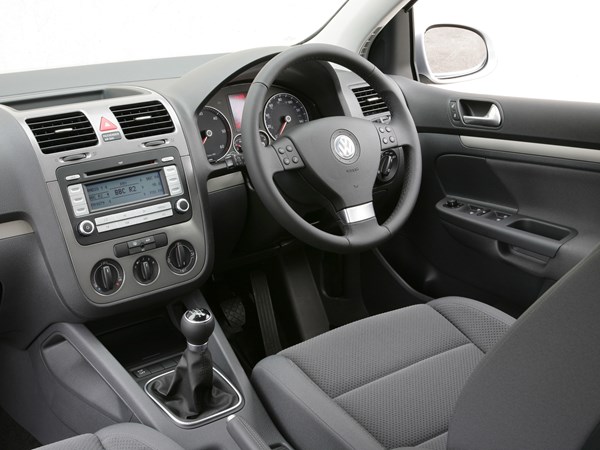
You can adjust the steering wheel for height and reach while the driver’s seat is multi-adjustable too, which makes for a comfortable driving position. As well as being attractive, the dashboard is functional with large, easy-to-use buttons and – where fitted – a simple sat nav system. All the controls are close to the driver for on-the-move adjustments and the screen is close enough so you don’t have to squint.
The system is a bit slow however, but cars from March 2008 come with a much faster and slicker system. The sat nav directions – as well as average fuel consumption, radio station, time and range are displayed in a panel in the instrument cluster, so you only have to momentarily take your eyes off the road.
Practicality
The Golf’s boot space is more than capable of coping with everyday family life. There are cupholders in all models and plenty of handy, well-thought-out storage space including deep door pockets and a large central cubby. A ‘storage pack’ was available too that includes a flip-down sunglasses pouch, cupholder and bottle opener.
What’s it like to drive?
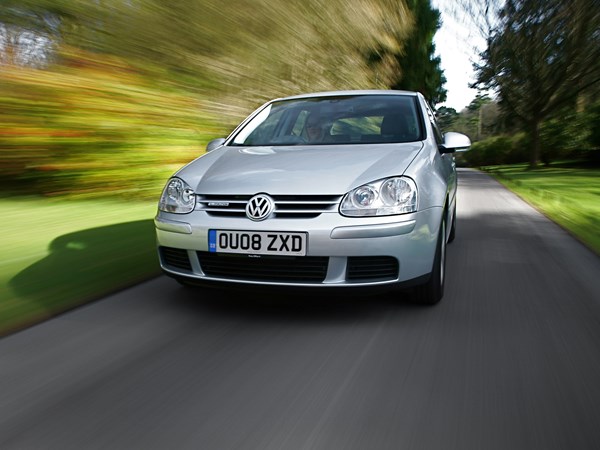
A standard 1.4-litre kicks off the range, but with only 75hp on offer, it feels weedy and doesn’t offer enough power for confident overtaking. The entry-level FSI is a 1.6-litre.
Volkswagen claims this petrol engine has diesel-like economy with petrol refinement, but in practice, you’ll need a delicate right foot to get near the claimed figures. A 1.4 TSI model was launched in summer 2006 and despite the small engine size, it’s available with 140hp and 170hp – that’s because it features both a supercharger and a turbo.
Both versions are excellent to drive, offering quick-off-the-mark performance, instant response and power when you need it. They’re economical too, as the fuel-hungry supercharging equipment cuts out when it’s not needed – mainly at higher speeds. It’s possible to get 38mpg and above in everyday driving, which makes the 1.4 TSI a faster, cheaper and quieter alternative to a diesel.
But Golf’s three diesels are superb, offering low fuel consumption, pace and power. The 2.0 SDI is a bit old fashioned, gutless and often hard work, so go for a 1.9 TDI or 2.0 TDI – they’re fast, torquey and fuel efficient, albeit noisy. The 1.9-litre gets 105hp or 115hp, while the 2.0-litre is available with 140hp and – from July 2006 – 170hp.
A tweaked version of the 1.9-litre TDI is used in the Bluemotion model which, coupled with longer gearing, helps to deliver lower emissions of 119g/km and an impressive economy figure of 63mpg – plus there’s no difference in performance over the standard 1.9 TDI. The Golf comes with either a five or six-speed manual and an excellent semi-automatic system called DSG.
Handling
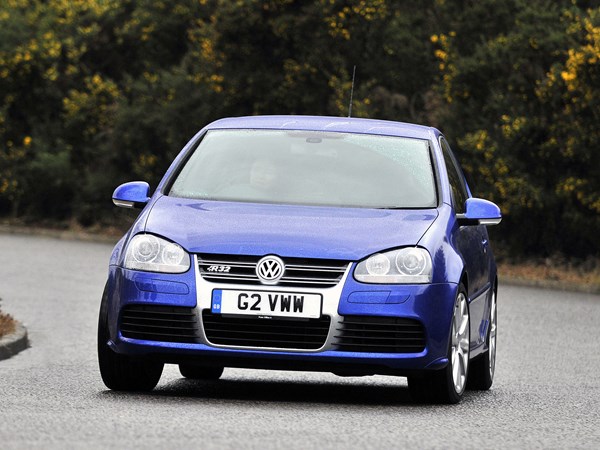
Comfortable, assured and predictable sums up the Golf. It’s not quite as involving as the Ford Focus or as agile as the Honda Civic but it’s enjoyable nonetheless and has excellent road manners.
The suspension is well controlled over most road surfaces and makes for a hushed and smooth ride, reflecting the Golf’s refined and grown-up nature. The slick gearbox offers quick and precise changes while the steering is nicely weighted and offers decent feedback.
Ownership and running costs
Fuel economy is pretty good, especially on the 1.4 TSI and diesel models while the Bluemotion model costs peanuts to run. The on board computer informs you when your car needs to be serviced, so intervals can be varied, depending on usage. Servicing costs themselves tend to be high in the Volkswagen dealer network due to high labour rates, though the costs of parts can be quite reasonable.
The Golf scores well on the eco front. With an average of 161g/km CO2 across the range, its emissions are relatively low for a family hatchback. Eco-conscious buyers and those looking to keep costs down should go for the Bluemotion model – thanks to emissions of just 119g/km it’s cheap to tax while it will average 63mpg. It looks like a standard Golf and drives just as well – plus comes with features such as air conditioning and ESP as standard.
There were a handful of minor teething problems, which were cleared up under warranty. Aside from that, this Golf is proving to be very reliable.
Safety
This generation Golf was the first Volkswagen to achieve a top five-star Euro NCAP crash test result. In addition, every car has two front air bags passenger, head airbags, anti-whiplash protection, five three-point seatbelts and Isofix child-seat anchor points. Driver and front passenger side airbags are standard, too.
All cars have an alarm, immobiliser and a stereo that’s unique to the car, as well as a key that’s difficult to copy.
What else should I know?
The Mk5 remained untouched visually during its lifetime, although a limited run of 1500 Edition 30 cars were released in October 2006 and there was another limited edition Pirelli model, both of which used a 230bhp version of the GTI engine with beefier turbos and camshafts. Needless to say, both are sought after.
A revelation in many respects, the Mk5 instantly put the Golf back into contention as the world’s best hatchback. But since the arrival of the Mk6 in 2008, Mk5 values have taken a hit, which means you can buy one for significantly less than you might have thought.



